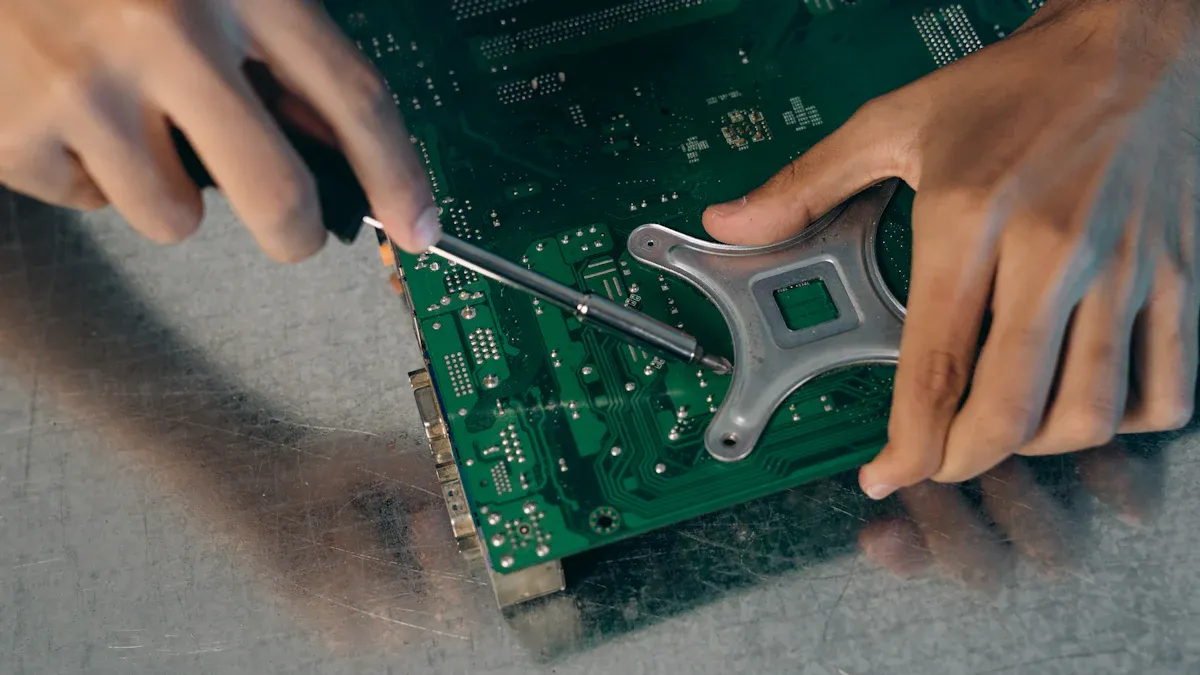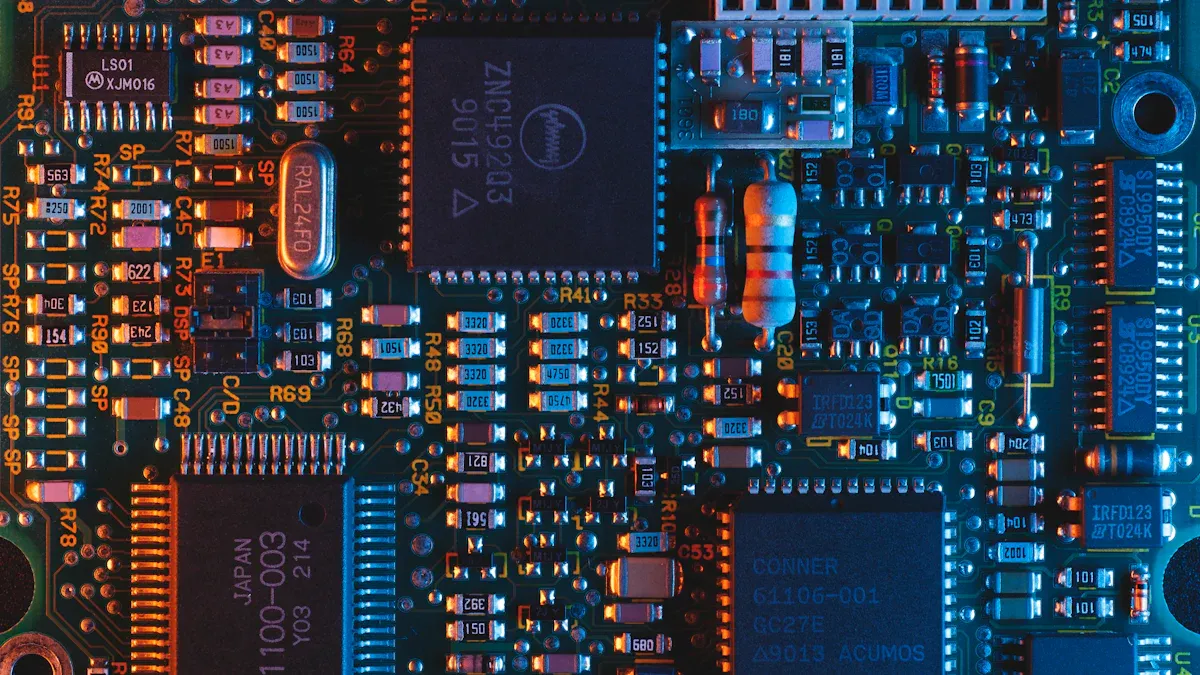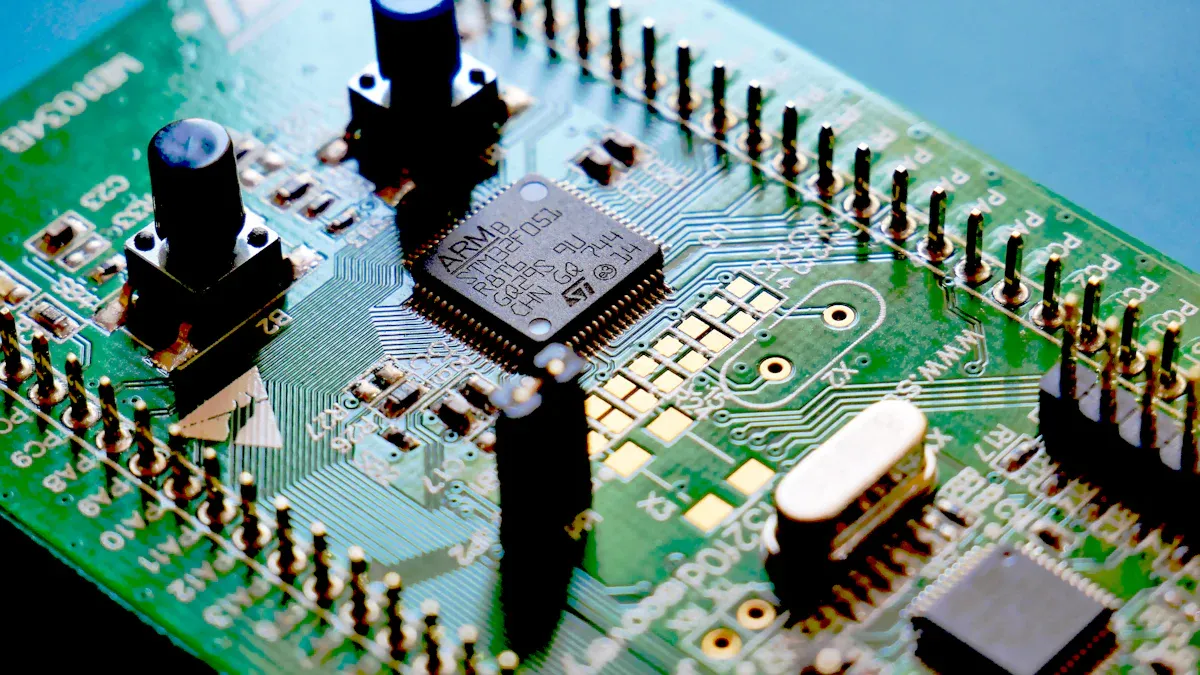
When making PCBs, the flux you pick is important, especially when considering water-soluble flux PCBA assembly. It affects cleaning and how reliable the board will be later. Water-soluble flux needs cleaning after soldering, which is crucial for removing residues that can cause rust or electrical problems. In contrast, no-clean flux leaves little residue, so cleaning is often skipped. For example, water-soluble flux must meet rules for cleanliness, ensuring that chloride levels stay below 0.75 µg/cm². No-clean flux follows stricter rules, like keeping solid content under 0.39 µg/cm². Choose based on your workspace, cleaning costs, and how the PCB will be used, particularly when opting for water-soluble flux PCBA assembly.
Key Takeaways
Water-soluble flux must be cleaned after soldering. This stops rust and electrical problems. Clean it well for good PCBs.
No-clean flux leaves little residue, so cleaning isn’t needed. This saves time and money, great for making many products fast.
Use water-soluble flux for important things like medical devices. It makes strong and clean solder connections.
Think about your project’s environment and how you’ll assemble it. Pick the right flux for your needs to get the best results.
Balance cost and performance. Use no-clean flux for quick tasks. Use water-soluble flux when reliability matters most.
What is Flux and Why Does it Matter?
What is Flux?
Flux is a chemical that helps during soldering. It cleans metal surfaces so solder sticks better. It removes dirt and rust, making the area ready for soldering. Flux types are grouped by how strong they are and if they have halides.
Flux Type | Strength | Halides Present |
|---|---|---|
RO | Low | None |
OR | Medium | Some |
IN | High | Some |
RE | High | Some |
These groups help you pick the right flux for your job.
How Flux Helps in Soldering
Flux is key to making strong solder joints. It stops rust from forming when metals touch air. Rust makes it hard for solder to stick. Flux clears this rust, letting solder flow and stick well.
Tests show stronger flux, like ROL1, cuts solder gaps by 20%. This happens because it cleans better, helping solder spread and stick. Without flux, soldering problems like weak joints are more common.
Why Flux is Important for Strong Solder Joints
Good solder joints keep PCBs working well and lasting long. Flux stops rust and helps solder stick to parts. It makes solder flow smoothly and bond tightly.
Studies show flux also helps solder resist electrical damage. A test score of over 100 MΩ shows flux keeps connections strong. Picking the right flux lowers soldering mistakes and keeps PCBs working longer.
Understanding Water-Soluble Flux in PCBA Assembly

Characteristics of Water-Soluble Flux
Water-soluble flux dissolves in water, making cleaning easier. It has organic acids and active ingredients that help clean well. This flux works across many soldering temperatures and times. It helps solder flow smoothly and stick to metal surfaces.
The residues left by this flux dissolve in water, simplifying cleanup. But if not cleaned properly, these residues can cause rust. Cleaning thoroughly is important to keep your PCB reliable.
Advantages of Water-Soluble Flux
Water-soluble flux has many benefits for PCB assembly.
High Activity: Strong chemicals make it work well in tough conditions.
Broad Temperature Range: It works at different soldering temperatures, giving flexibility.
Improved Mechanical Resistance: It creates strong solder joints, making PCBs last longer.
Here’s a table showing the pros and cons of water-soluble flux:
Advantages | Challenges |
|---|---|
High activity | Can cause rust if not cleaned |
Works at many temperatures | Needs cleaning for reliability |
Makes strong solder joints | Cleaning can damage delicate parts |
Disadvantages of Water-Soluble Flux
Water-soluble flux has some downsides you should know.
Corrosive Residues: If not cleaned, residues can rust metal parts. This may cause PCB problems later.
Cleaning Requirements: You must clean after soldering, which adds time and cost.
Risk of Damage During Cleaning: Strong cleaning methods can harm fragile PCB parts. Use gentle cleaning techniques to avoid damage.
When using water-soluble flux, weigh its pros and cons to decide if it fits your project.
Common Uses of Water-Soluble Flux
Water-soluble flux is important in many PCB assembly tasks. Its special features make it great for jobs needing cleaning and reliability. It is often used in these cases:
High-Reliability Electronics:
This flux works well for devices like medical tools, space systems, and military gadgets. These need to last long and be very reliable. Cleaning is key to stop rust or electrical problems.Complex PCB Designs:
For boards with many layers or tiny parts, this flux helps. It makes strong solder joints even in tight spaces or tricky designs.Prototyping and Development:
When testing and changing circuits, this flux is useful. It allows easy cleaning, so you can adjust circuits without leftover residue.Automotive Electronics:
Car systems face heat and moisture. This flux makes strong solder joints and avoids problems from residue buildup.
Tip: Pick water-soluble flux for projects needing clean and reliable results. Always clean well to avoid damage from leftover residue.
High-Temperature Soldering:
This flux works well at high temperatures. It stays active and gives steady results during soldering.Industrial Equipment:
Machines in tough conditions need strong PCBs. This flux helps make solid connections that handle stress and harsh environments.
Knowing these uses helps you decide if this flux fits your project. Always think about cleaning needs and where the PCB will be used.
Exploring No-Clean Flux
Characteristics of No-Clean Flux
No-clean flux leaves very little residue after soldering. This means you don’t need to clean the PCB afterward. It has low solid content, so less residue is left behind. The residue is safe because it doesn’t cause rust or conduct electricity.
There are two types of no-clean flux: low-solids and high-solids. Low-solids flux is best when you want almost no residue. High-solids flux works better for tough soldering jobs.
Characteristic/Performance Metric | Description |
|---|---|
Types of No-Clean Fluxes | Low-solids and high-solids for different needs. |
Application Methods | Foam, wave, and spray fluxing work well. |
Reliability Testing | Tested in harsh conditions (35°C, 90% humidity for 1,000 hours). |
Quality Considerations | Tracks defects like bridges and skips. |
Cosmetic Appearance | Residue may show but doesn’t harm performance. |
Testability | Ensures electrical testing after assembly is possible. |
Process Considerations | Needs careful material choice for cleanliness. |
Tests show no-clean flux works well over time. For example, PCBs with this flux were tested in tough conditions. They stayed reliable at 35°C and 90% humidity for 1,000 hours.
Advantages of No-Clean Flux
No-clean flux has many benefits for PCB assembly:
No Cleaning Needed: You save time and money by skipping cleaning.
Lower Costs: No cleaning means no extra equipment or chemicals.
Eco-Friendly: Without cleaning, there’s less water and chemical waste.
Faster Production: It makes the assembly process quicker and easier.
Good Performance: The residue doesn’t harm the PCB’s function.
Tip: Choose no-clean flux for projects where cleaning isn’t needed. It’s great for making lots of products quickly, like consumer electronics.
Disadvantages of No-Clean Flux
No-clean flux also has some downsides to think about:
Residue Can Show: The residue is harmless but might not look good. This matters for products needing a clean look.
Not for All Industries: Some fields, like medical or aerospace, need very clean PCBs. No-clean flux might not meet their strict rules.
Testing Problems: Residue can make some tests harder to do.
Material Issues: Make sure the flux works with all your materials to avoid problems.
Note: Think about your project’s needs before picking no-clean flux. Check if residue, testing, or cleanliness rules matter for your work.
Common Applications of No-Clean Flux
No-clean flux is useful in many PCB assembly tasks. It works well when cleaning isn’t needed or possible. Industries that focus on saving money and time often use it.
Consumer Electronics
No-clean flux is common in devices like phones, tablets, and laptops. These products are made in large amounts. Skipping cleaning saves time and lowers costs. The small residue left doesn’t harm how these devices work. This makes it great for fast production.Telecommunication Equipment
Routers and modems often use no-clean flux during assembly. These devices need strong solder joints but don’t require strict cleaning rules. No-clean flux keeps costs low while ensuring reliable connections.Automotive Electronics
Car parts like sensors and control modules use no-clean flux. These parts face tough conditions like heat and shaking. No-clean flux makes strong solder joints without needing cleaning. This helps simplify the manufacturing process.LED Lighting Systems
LED lights benefit from no-clean flux because they are small and made in large numbers. Cleaning tiny parts can be hard. No-clean flux skips this step, making assembly faster and easier.Industrial Electronics
Machines like control panels and power supplies use no-clean flux. These systems work in tough places but don’t always need strict cleaning. No-clean flux saves time and money during production.Wearable Devices
Fitness trackers and smartwatches often use no-clean flux. These gadgets are small and tricky to clean. No-clean flux leaves safe residue that doesn’t affect how they work.
Tip: Think about the product’s use and cleanliness needs before choosing no-clean flux. It’s a smart choice for projects with high production or no cleaning required.
Knowing these uses helps you decide if no-clean flux fits your project. It’s popular because it saves time and reduces costs across many industries.
Comparing Water-Soluble Flux and No-Clean Flux

Cleaning Needs
Cleaning is a big difference between water-soluble flux and no-clean flux. Water-soluble flux needs cleaning after soldering. Its strong chemicals leave residue that can harm metal parts. Cleaning removes this residue and keeps the PCB working well. But cleaning takes extra time and costs more.
No-clean flux usually skips cleaning. It leaves very little residue that is safe and doesn’t cause rust. This makes production faster and cheaper. However, some industries with strict rules may still clean no-clean flux PCBs.
Flux Type | Cleaning Needs | Performance Features |
|---|---|---|
Water-Soluble Flux | Needs cleaning after soldering due to strong residue. | Works well but can corrode if not cleaned. |
No-Clean Flux | Usually doesn’t need cleaning; leaves tiny residue. | Easier assembly but may not solder as strongly. |
Tip: Use water-soluble flux for clean, reliable boards. Pick no-clean flux for faster, cheaper production.
Residue and PCB Reliability
Residue affects how reliable your PCB will be. Water-soluble flux leaves active residue that can rust or cause electrical problems. Cleaning removes this residue and keeps the PCB working longer.
No-clean flux leaves very little residue that doesn’t rust or conduct electricity. This residue is safe for most uses. But in humid or extreme places, even small residue might cause issues.
Note: Think about where your PCB will be used when choosing flux.
Where to Use Each Flux
Where your PCB will be used helps decide the flux type. Water-soluble flux is best for medical tools, space systems, and car electronics. These need clean boards to work well for a long time.
No-clean flux is great for phones, routers, and factory machines. These focus on saving money and making products quickly. For example, LED lights are made faster with no-clean flux.
Tip: Match the flux to your project’s needs. Clean boards need water-soluble flux. Fast production works better with no-clean flux.
Cost and Process Efficiency
Picking between water-soluble flux and no-clean flux affects costs. Each type has pros and cons that impact your budget and workflow.
Water-Soluble Flux: Cost and Process Details
Water-soluble flux needs cleaning after soldering. Cleaning adds costs for tools, water, and labor. Fragile parts may need special cleaning, which costs more.
But this flux is reliable, making it worth the cost for industries like aerospace or medical devices. Spending more upfront on cleaning helps avoid repairs later.
Tip: Pick water-soluble flux when reliability matters more than initial costs.
No-Clean Flux: Cost and Process Details
No-clean flux skips cleaning, saving time and money. It speeds up production and lowers costs for tools and labor. This makes it great for making lots of products quickly.
However, leftover residue might not meet strict rules in some industries. This could cause problems over time.
Flux Type | Starting Costs | Future Costs | Process Speed |
|---|---|---|---|
Water-Soluble Flux | Higher | Lower (due to reliability) | Slower (needs cleaning) |
No-Clean Flux | Lower | Higher (if residue causes issues) | Faster (no cleaning needed) |
Note: Use no-clean flux for projects needing quick and cheap assembly.
Balancing Costs and Speed
Think about short-term costs versus long-term reliability. Water-soluble flux is best for clean, durable boards. No-clean flux works for fast, low-cost assembly.
Emoji Insight: 💡 Efficiency Tip: Choose flux based on your project’s needs—speed or reliability.
Choosing the Right Flux for Your PCB Assembly
Factors to Consider
Picking the right flux for your PCB needs careful thought. Think about where the circuit board will be used. Moisture, temperature changes, and dirt can affect how well it works. For example, water-soluble flux is great in wet places. It removes residues that might harm metal parts.
The way you assemble the PCB also matters. SMT often uses no-clean flux because it’s faster and skips cleaning. But THT usually needs water-soluble flux for strong solder joints and clean connections.
Also, consider what the PCB will do. Important devices like medical tools or space systems need clean, reliable boards. Water-soluble flux is best for these. The height of parts also matters. Taller parts can trap air, causing solder gaps. Water-soluble flux helps avoid this problem.
Tip: Choose flux based on your assembly method and where the PCB will be used.
Practical Tips for Selection
Follow these steps to pick the right flux easily:
Check the Environment: Know if your PCB will face moisture or heat.
Understand Assembly Needs: Decide if you’re using SMT or THT and pick flux to match.
Think About the Application: For important uses, pick flux that ensures clean, strong solder joints.
Test Materials: Make sure the flux works with your parts to avoid problems.
By focusing on these points, you can improve soldering and avoid risks.
Balancing Cost and Performance
It’s important to balance cost and performance in PCB assembly. You can save money while keeping quality high by following smart practices.
Design PCBs to make cleaning easier and reduce residue.
Use no-clean flux for faster, cheaper production.
Apply flux carefully to avoid wasting it.
Pick water-based cleaners to protect the environment.
Use energy-saving cleaning tools to cut costs.
Handle leftover residues responsibly to avoid waste.
Try new cleaning methods, like plasma cleaning, when needed.
Watch your process closely to keep results consistent.
Work with suppliers to find eco-friendly materials.
Stay updated on rules to avoid breaking them.
Check the full cost and environmental impact of your flux choice.
Emoji Insight: 💡 Efficiency Tip: Save money and improve results by choosing the right flux and smart practices.
By balancing these ideas, you can get great soldering results without spending too much.
Picking water-soluble or no-clean flux depends on your project. Water-soluble flux needs cleaning but is very reliable. It’s great for important uses like medical tools or space systems. No-clean flux skips cleaning, saving time and money. This works well for gadgets or making lots of products fast. Think about your process, environment, and reliability needs before choosing. Always check rules to meet standards and get the best results. Knowing how water-soluble flux works helps you choose better for your PCB projects.
FAQ
1. What happens if you don’t clean water-soluble flux residue?
Not cleaning water-soluble flux can harm your PCB. The residue reacts with water and metal, causing rust or shorts. Always clean it to keep your PCB working well.
2. Can you use no-clean flux for high-reliability applications?
No-clean flux is fine for many uses but not for strict industries. Medical tools and space systems need clean boards to meet rules. Use water-soluble flux for important projects.
3. Does no-clean flux affect PCB testing?
No-clean flux residue can mess up some tests. It might give wrong results or make testing harder. If testing matters, clean the residue or use water-soluble flux.
4. How do you choose between water-soluble and no-clean flux?
Think about your project’s needs and costs. Water-soluble flux is best for clean boards in tough places. No-clean flux works for quick and cheap production in easier conditions.
5. Is cleaning water-soluble flux expensive?
Cleaning costs money for tools and workers. But it stops damage and keeps your PCB reliable. For important jobs, cleaning is worth the cost.
See Also
The Importance of PCBA Cleanliness for Dependable Performance
Essential Strategies to Enhance PCB Assembly Productivity
Understanding the SMT Process in PCB Assembly Operations